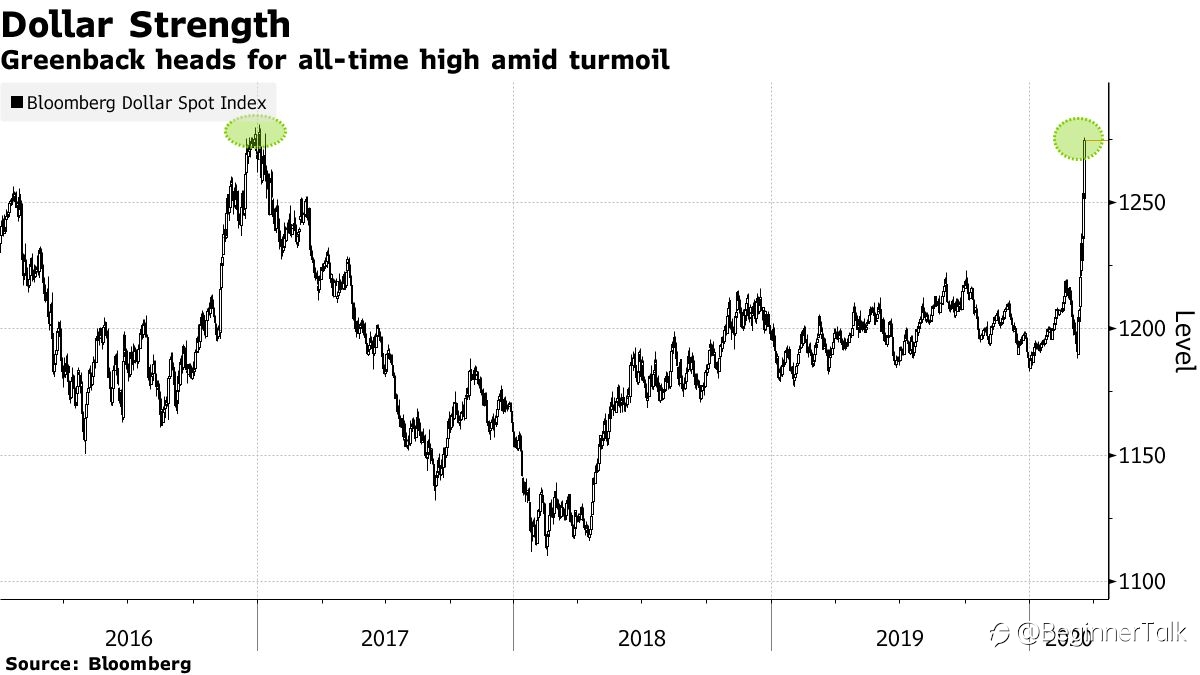Bloomberg Dollar Spot Index
The Bloomberg Dollar Spot Index (BBDXY) tracks the performance of a basket of 10 global currencies against the U.S. dollar.
Its composition is updated annually and represents a diverse set of currencies that are important from a global trade and liquidity perspective.

Since other dollar indices (ahem…DXY) do not update their composition and are comprised of only a handful of currencies with concentrated weights, Bloomberg claims their index provides a better measure of the U.S. dollar.

The BBDXY Index data starts from Dec 31, 2004, with a base level of 1000.
Each currency in the basket and its weight is determined annually based on its share of international trade and FX liquidity.

A Better Measure of the U.S. Dollar?
Let’s see how the Bloomberg Dollar Spot Index (BBDXY) differs from the widely used ICE Dollar Index (DXY).
BBDXY is more representative.
The Bloomberg Dollar Spot Index tracks a more representative basket of currencies by considering global currency market liquidity and trading partners of the U.S.

BBDXY is more diversified.
Unlike DXY, the Bloomberg Dollar Spot Index is NOT dominated by the euro.

It also includes major emerging market currencies such as the Indian rupee, Korean won, Mexican peso, and Chinese renminbi which are all major trading partners of the U.S.

BBDXY is more dynamic.
Unlike the DXY’s static composition, BBDXY is dynamic, with an annual rebalancing process that captures the changing state of currency markets.
This results in the index that includes important currencies (like the Australian dollar) that rank higher in liquidity and trading versus the Swedish krona.
Why does USDX include Sweden? Because the index still livin’ in the past! The ICE U.S. Dollar Index measures the value of the U.S. Dollar against a basket of currencies of the top six trading partners of the United States, as measured in 1973! This included the Euro zone, Japan, the United Kingdom, Canada, Sweden, and Switzerland.
Here’s a snapshot of how the Bloomberg Dollar Index has rebalanced over the years.

Notice how currencies like the Singaporean dollar (SGD) and Brazilian real (BRL) used to be part of the cool club but eventually got the boot and were replaced.
BBDXY don’t play around. It likes to keep it fresh!
This is in contrast to the U.S. Dollar Index (USDX, DXY, DX) where the currencies never change. Maybe they should call themselves the “Boring Dollar Index”. 😂
Which Currencies Are Part of the Bloomberg Dollar Spot Index?
Here is the most recent composition of the Bloomberg Dollar Spot Index compared to the previous year.

How the Bloomberg Dollar Spot Index Determines Which Currencies to Include
The index rebalances once a year to incorporate new data from:
- The annual survey of major trading partners versus the U.S. dollar as reported by the Federal Reserve.
- The triennial survey of most liquid currencies as reported by the Bank of International Settlements (BIS).
Currencies pegged to the U.S. dollar are excluded and currencies heavily managed (like the Chinese renminbi) have their exposure capped.
To ensure tradability, currencies with weights of less than 2% are removed.
At each annual rebalance, the following steps are taken to select which currencies to include and their weights:
- Identify the top 20 currencies in terms of trading activity versus the underlying currency. For the U.S. dollar, this is as defined by the Federal Reserve in its Broad Index of the Foreign Exchange Value of the Dollar.
- Identify the top 20 currencies from the Triennial Central Bank Survey of Foreign Exchange and Derivatives Market Activity. Specific information about foreign exchange turnover can be found here.
- Select the top 10 currencies of both lists, but exclude any pegged currencies. For example, currencies pegged to the U.S. dollar (such as the Hong Kong dollar or Saudi riyal) are removed for the Bloomberg Dollar Spot Index.
- Assign a preliminary weight for each currency based on its trade weight and liquidity weight.
- Cap the exposure of Chinese renminbi and remove smaller currency positions, defined as any position that has a weight of less than 2%.
- Voila! BBDXY calculation complete!
The rebalanced target weights are applied after the close of the last U.S trading day in December every year.
Here’s a chart that visualizes the above process:

How to View the Bloomberg Dollar Spot Index
For Bloomberg subscribers, you can run BDXY on the Bloomberg Terminal® to view the Bloomberg Dollar Spot Index.
But if you can’t afford to pay the $20,000 annual fee for a Bloomberg Terminal subscription, you can access the live BBDXY quote for free on Bloomberg’s website.
On Bloomberg’s BBDXY page, you’ll see a live quote that looks like this:

You can even view a full chart by clicking near the top right corner.

You can also access the DXY quote on Bloomberg’s website as well.
Reprinted from Babypips, the copyright all reserved by the original author.
Disclaimer: The content above represents only the views of the author or guest. It does not represent any views or positions of FOLLOWME and does not mean that FOLLOWME agrees with its statement or description, nor does it constitute any investment advice. For all actions taken by visitors based on information provided by the FOLLOWME community, the community does not assume any form of liability unless otherwise expressly promised in writing.
FOLLOWME Trading Community Website: https://www.followme.com



Hot
No comment on record. Start new comment.